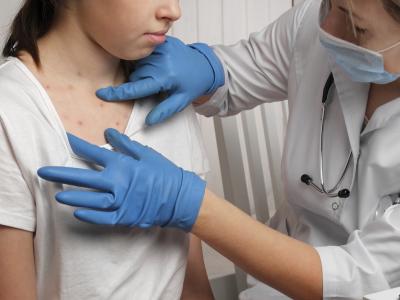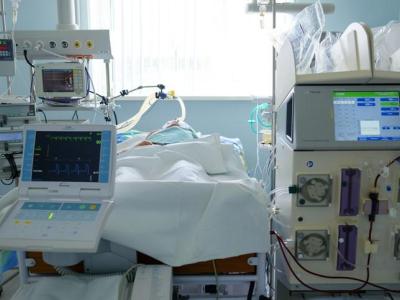Our weekly wrap-up of antimicrobial stewardship & antimicrobial resistance scans
NIAID awards grants for bacteriophage research
The National Institute of Allergy and Infectious Diseases (NIAID) announced yesterday that it has awarded $2.5 million in grants to support research on bacteriophage therapy.
Bacteriophages are viruses that can kill or incapacitate specific kinds of bacteria while leaving other bacteria and human cells unharmed. Scientists have been aware of the ability of bacteriophages to kill bacteria since 1917, but research withered after the discovery of antibiotics. Renewed interest has grown with the emergence of antibiotic resistance, and several case studies involving individual patients have demonstrated that bacteriophage therapy may be helpful in treating multidrug-resistant infections.
"In recent decades, multidrug-resistant bacteria, particularly those that cause potentially deadly diseases like tuberculosis, have become a serious and growing global public health concern," NIAID Director Anthony S. Fauci, MD, said in a National Institutes of Health (NIH) press release. "With these awards, NIAID is supporting research needed to determine if phage therapy might be used in combination with antibiotics—or replace them altogether—in treating evolving antibiotic-resistant bacterial diseases."
The NIAID grants will support bacteriophage research at 12 institutes. Among the projects being supported are a study characterizing different types of phages, a project exploring how phages combat biofilms, and a study examining optimum delivery methods for phages targeting Mycobacterium tuberculosis.
Mar 11 NIH press release
Higher nursing home use of certain antibiotics, COVID therapies noted
Originally published by CIDRAP News Mar 11
US nursing homes saw an increase in prescribing of antibiotics commonly used for respiratory infections during the pandemic, and large number of residents were prescribed drugs being evaluated for COVID-19 treatment, according to a study yesterday in Clinical Infectious Diseases.
For the study, researchers with the Centers for Disease Control and Prevention (CDC) looked at long-term care pharmacy data from 1,944 nursing homes in 48 states, assessing two categories of drugs: antibiotics and drugs that were being investigated for COVID-19 treatment, including hydroxychloroquine, famotidine, and dexamethasone. To account for seasonal variability in antibiotic prescribing and decreased nursing home occupancy during the pandemic, the researchers calculated the monthly prevalence of residents with a prescription dispensed per 1,000 residents from January to October 2020, then calculated the monthly relative percent change from 2019 to 2020.
From March to October 2020, prescribing of azithromycin and hydroxychloroquine per 1,000 residents was higher than 2019, most notably in April, when hydroxychloroquine prescribing was 563% higher (prevalence ratio [PR], 6.63; 95% confidence interval [CI], 5.87 to 7.48) and azithromycin prescribing was 150% higher (PR, 2.50; 95% CI, 2.37 to 2.63). Prescribing of these drugs declined in May 2020, but was still significantly higher than 2019 from July through October 2020. Prescribing of famotidine was 59% higher in April 2020 compared with 2019, while dexamethasone was 303% higher by July 2020.
In addition to azithromycin, prescribing of ceftriaxone was 43% higher in April 2020 versus 2019 and prescribing of doxycycline was 6% higher. Ceftriaxone use remained significantly elevated from May (+22%) through October 2020 (+11%) compared with 2019. But total antibiotic prescribing among nursing home residents was lower from May (-5%) through October 2020 (-4%) compared with 2019.
The study authors say the increases in prescribing of these drugs to nursing home residents without clear benefits are concerning, as they could put residents at greater risk for adverse events. They say further studies linking prescribing data to diagnoses and outcomes are needed to determine how appropriate these prescriptions were and what health impacts they had.
Mar 10 Clin Infect Dis abstract
Pew analysis shows antibiotic development pipeline remains thin
Originally published by CIDRAP News Mar 11
The latest analysis of the antibiotic development pipeline by the Pew Charitable Trusts shows there are still too few antibiotics in development to meet current and anticipated needs.
The analysis shows 43 antibiotics with the potential to treat serious bacterial infections were in clinical development as of December 2020, with 15 in phase 1 clinical trials, 13 in phase 2, 13 in phase 3, and 2 with new drug applications submitted to the Food and Drug Administration (FDA). Historically, only 1 in 5 infectious disease drugs that reach phase 1 studies will receive FDA approval, and roughly 60% of those that reach phase 3 will be approved.
At least 19 of the drugs in clinical development have the potential to treat gram-negative ESKAPE pathogens, which is a critical area of unmet need, and at least 15 have the potential activity against carbapenem-resistant/extended-spectrum beta-lactamase (ESBL)-producing Enterobacteriaceae, Acinetobacter baumannii, and Pseudomonas aeruginosa, which are considered high priority threats by the World Health Organization (WHO). At least 10 of the antibiotics, if approved, could address infections caused by drug-resistant Neisseria gonorrhea and Clostridioides difficile.
Only 10 drugs in the pipeline represent a novel antibiotic class or mechanism of action, according to Pew, and none are active against gram-negative ESKAPE pathogens or WHO critical-threat bacteria.
The analysis also found that only two of the companies with antibiotics in development rank among the top 50 pharmaceutical companies by sales, which is further indication that large pharmaceutical companies are abandoning antibiotic development.
Mar 9 Pew antibiotic pipeline analysis
Study links antibiotic order sets to improved ED prescribing
Originally published by CIDRAP News Mar 10
Use of antibiotic order sets built into the electronic medical record for common infectious diagnoses in the emergency department (ED) was associated with improved antibiotic prescribing at an academic medical center, Emory University researchers reported yesterday in Infection Control & Hospital Epidemiology.
The order sets at Emory University Hospital were created for cystitis, pyelonephritis, pneumonia, chronic obstructive pulmonary disease, and cellulitis and included recommended antibiotics based on clinical practice guidelines and a recommendation for the first dose to be given in the ED, along with a pre-populated prescription for appropriate duration.
The order sets were deployed in March 2019, and a survey was sent in November 2019 to assess whether the sets were being used. The researchers also conducted a chart review from October to November 2019 to assess the impact on prescribing practices for patients presenting with one of the five diagnoses.
While 59.4% of survey respondents said they used the order sets, the chart review showed that in 104 qualifying patient encounters, order sets were used in only 22 (21%). But patients were more likely to receive the first antibiotic dose in the ED when the order sets were used than when they were not used (90.9% versus 71.2%), and were also more likely to receive an appropriate antibiotic (86.4% vs 33.8%) and to have an appropriate duration prescribed (68.2% vs 24.5%). The researchers did not detect a statistically significant difference in appropriate renal dosing between the two groups.
Almost all providers who used the order sets noted they were easy to use and saved time.
The authors say larger studies are needed to evaluate the impact of order sets on prescribing and patient outcomes.
Mar 9 Infect Control Hosp Epidemiol study
CARB-X to fund development of Staphylococcus aureus vaccine
Originally published by CIDRAP News Mar 9
CARB-X today awarded up to $3.5 million to biotechnology company Affinivax, of Cambridge, Massachusetts, for preclinical development of a vaccine against Staphylococcus aureus infections.
The vaccine being developed by Affinivax, using its Multiple Antigen Presenting System (MAPS) technology, will include multiple staphylococcal protein antigens designed to elicit B cell antibody and Th17 and Th1 cell-mediated immune responses. It offers the potential for protection against mucosal colonization and invasive staphylococcal infections. Company leaders believe this approach could help them overcome hurdles that have thwarted other attempts at developing an S aureusvaccine.
"Data from our group and others support the view that, in addition to antibodies, Th1 and Th17 responses to S. aureus proteins are critical to achieve broad protection against this pathogen," Richard Malley, MD, scientific founder of Affinivax and a professor of pediatrics at Harvard Medical School, said in a CARB-X (the Combating Antibiotic Resistant Bacteria Biopharmaceutical Accelerator) press release. "Our MAPS technology is ideally suited for this purpose."
S aureus can cause a range of disease, from minor skin infections to life-threatening bloodstream infections, and methicillin-resistant S aureus (MRSA) infections have limited treatment options. MRSA is labeled a serious threat by the CDC.
The project could be eligible for an additional $18.5 million in funding if it reaches certain development milestones.
Mar 9 CARB-X press release
Genomic analysis shows growth of resistance genes in diphtheria
Originally published by CIDRAP News Mar 8
Genomic analysis of Corynebacterium diphtheriae—the bacterium that causes the respiratory disease diphtheria—showed an increase in the average number of antimicrobial resistance (AMR) genes per genome per decade, UK and Indian scientists reported today in Nature Communications.
In the study, a team led by researchers from the University of Cambridge analyzed a collection of 502 C diphtheriae genomes that included 61 novel isolates from India, which has reported the highest number of diphtheria cases in the last few years, and 441 publicly available genomes. The isolates in the study covered 16 countries and territories and were collected over 122 years.
The analysis revealed that C diphtheriae is a genetically diverse species, with multiple distinct clonal populations circulating in the same geographic location, and that the more recently isolated genomes had a disproportionately high number of AMR genes, with a significant positive correlation between the average number of AMR genes per genome and the decade of isolation. Isolates collected from 2010 through 2019 had almost four times as many AMR genes as those collected in the 1990s.
The sulphonamide resistance gene sull was the common AMR gene detected and was found mainly in Indian isolates, along with aminoglycoside, chloramphenicol and trimethoprim resistance genes. Only one macrolide resistance gene was found, and no beta-lactam resistance genes were detected. This is noteworthy because erythromycin and penicillin are the traditionally recommended antibiotics of choice for early-stage diphtheria.
The study authors suggest the bacterium may be acquiring resistance genes in response to antibiotics exposure in the environment or during treatment for other bacterial infections.
In addition, the analysis found 18 different variants of the diphtheria toxin gene, which is the main virulence factor associated with the disease and is the target of the vaccine. Although diphtheria vaccines have been around for decades and remain effective, the number of cases reported globally has increased in recent years, and the authors say it's important to understand how the disease is evolving and spreading.
"We mustn't take our eye off the ball with diphtheria, otherwise we risk it becoming a major global threat again, potentially in a modified, better adapted, form," lead author Ankur Mutreja, PhD, of the Cambridge Institute of Therapeutic Immunology & Infectious Disease, said in a university press release.
Mar 8 Nat Comm study
Mar 8 University of Cambridge press release













